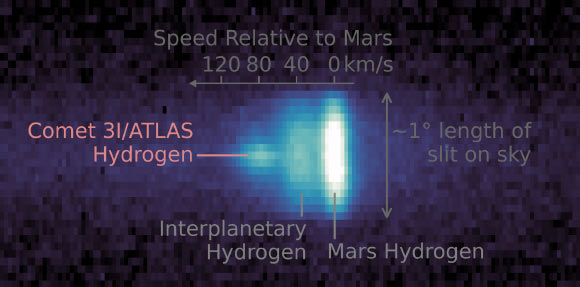New ultraviolet (UV) images obtained Ultraviolet Imaging Spectrograph (IUVS) camera on board NASA MAVEN (Martian Atmosphere and Volatile Evolution) orbiter unique among all observations of an interstellar comet 3I/ATLAS in determining its chemical composition and the amount of water vapor released when the comet is heated by the Sun. These details will help scientists better understand the past, present and future of 3I/ATLAS.
This ultraviolet image shows coma 3I/ATLAS taken on October 9, 2025 by NASA's MAVEN spacecraft using the IUVS camera. The brightest pixel in the center indicates where the comet is located. The surrounding bright pixels show where hydrogen atoms were detected emanating from the comet. Image credit: NASA/Goddard/LASP/CU Boulder.
For 10 days starting September 27, 2025, MAVEN imaged 3I/ATLAS in two unique ways using its IUVS camera.
First, IUVS took multiple images of the comet at different wavelengths, similar to using different filters on a camera.
He then took high-resolution UV images to identify the hydrogen coming from 3I/ATLAS.
By studying the combination of these images, scientists will be able to identify different molecules and better understand the composition of the comet.
“The images captured by MAVEN are truly incredible,” said MAVEN Principal Investigator Dr. Shannon Curry, a researcher from
“The findings we are seeing are significant, and we have only scratched the surface of our analysis.”

This annotated composite image showing hydrogen atoms from three sources, including 3I/ATLAS (left), was acquired on September 28, 2025 by NASA's MAVEN orbiter using the IUVS camera. Hydrogen emitted by Mars is the bright band on the right, while interplanetary hydrogen flowing through the solar system is indicated by the fainter band in the middle. Image credit: NASA/Goddard/LASP/CU Boulder.
The IUVS data also allows us to estimate the upper limit of the ratio of deuterium to ordinary hydrogen in the comet, which is an indicator of the origin and evolution of the comet.
When the comet was closest to Mars, Dr. Curry and his colleagues used the more sensitive IUVS channels to map different atoms and molecules in the comet's coma, such as hydrogen and hydroxyl.
Further study of the comet's chemical composition could reveal more about its origins and evolution.
“When we saw what we captured, we had a lot of adrenaline,” said MAVEN deputy principal investigator Dr. Justin Deighan, also of the University of Colorado Boulder's Atmospheric and Space Physics Laboratory.
“Every measurement we take of this comet helps unlock new understanding of interstellar objects.”








